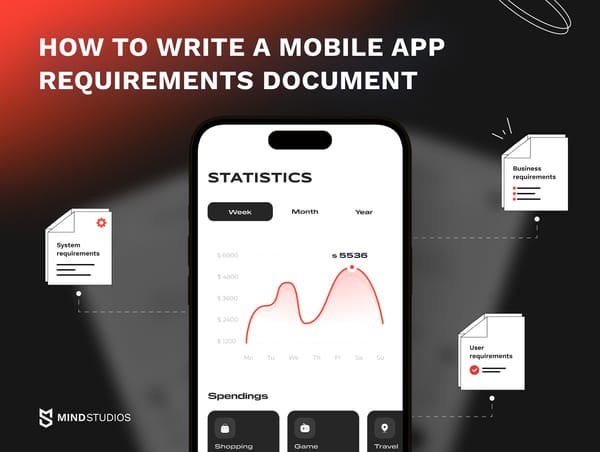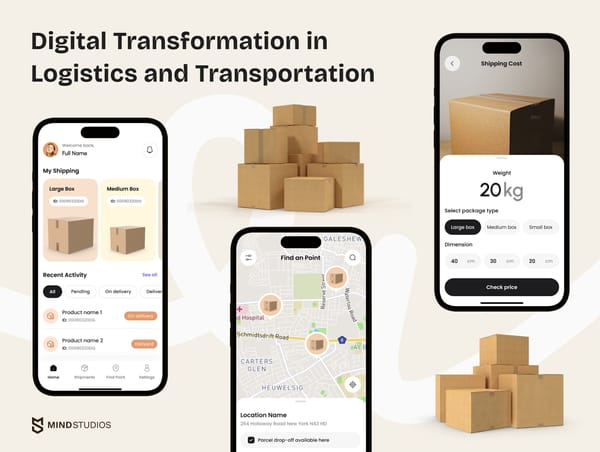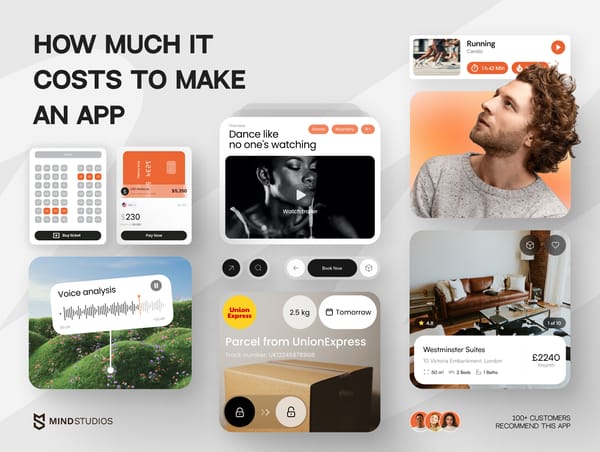What can be an indicator of well-coordinated teamwork? There have been many examples in our nine years of experience, but perhaps the most revealing one was the James Butler delivery mobile app project. We needed to organize the mobile app development process so smoothly that we could build four mobile apps — separately for buyers and couriers on iOS and Android platforms — in just three months.
Knowing the secret of a well-organized mobile application development team firsthand, in this article, we unlock it by sharing principles for structuring your team, assigning roles and responsibilities, and picking the right specialists to successfully develop your app. We’ll introduce you to five ways of recruiting developers to your team and compare their cost-efficiency to enable you to plan your budget.
Mobile app development team structure
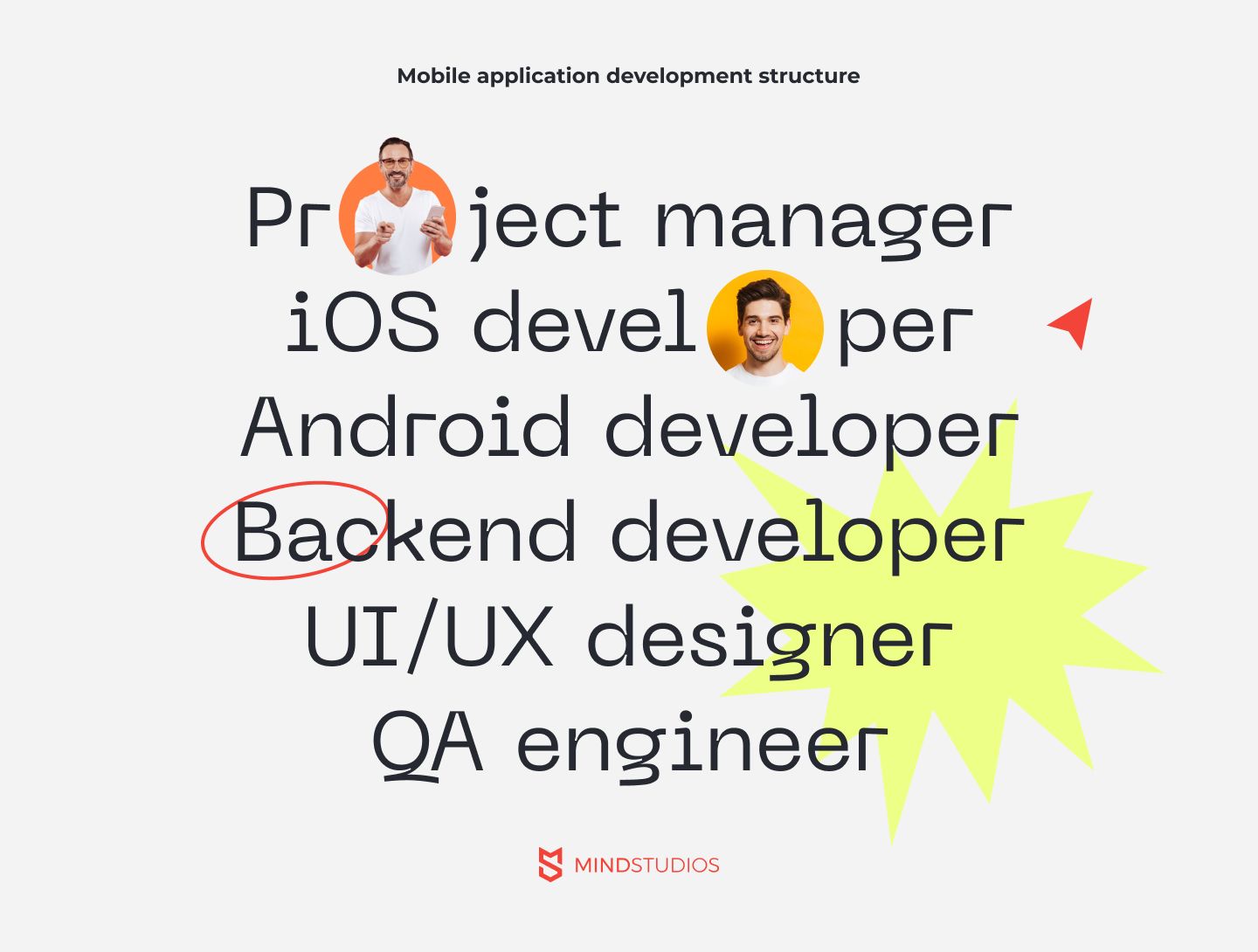
Identifying which and how many specific experts would be required to complete your mobile app development project is the first step in assembling a mobile development team. Given that the number of staff members needed to build an app is highly dependent on the scope and complexity of the project at hand, let's start with the bare minimum of who is needed to make a mobile app:
- 1 project manager / product manager
- 1 UI/UX designer
- 1 iOS developer
- 1 Android developer
- 1 backend developer
- 1 quality assurance engineer
Project manager / product manager
When you come to a mobile app development company with your app idea, you’ll be assigned a project manager (PM) to be your assistant and your link to developers. A project manager takes responsibility for a project from start to finish.
Product manager is often mistakenly used as a synonym for project manager. But while these two specialists are both managers, they carry out different tasks and have different responsibilities. The difference is in what they’re managing — a project vs a product. A project is finite, with a clear plan of activities and specified start and end dates. A product needs to generate continuous value for users and has no time limits.
A project manager focuses primarily on the performance of the app development process, adherence to deadlines, and quality standards based on the product manager’s vision.
The project manager’s responsibilities include:
- Handing out assignments to the development team, setting terms for sprints, and prioritizing tasks
- Estimating your project and staying within your budget
- Building communication between you as the client and developers as contractors
- Adapting changes to the app development plan
- Maintaining quality, hitting deadlines, and keeping costs from running out of control
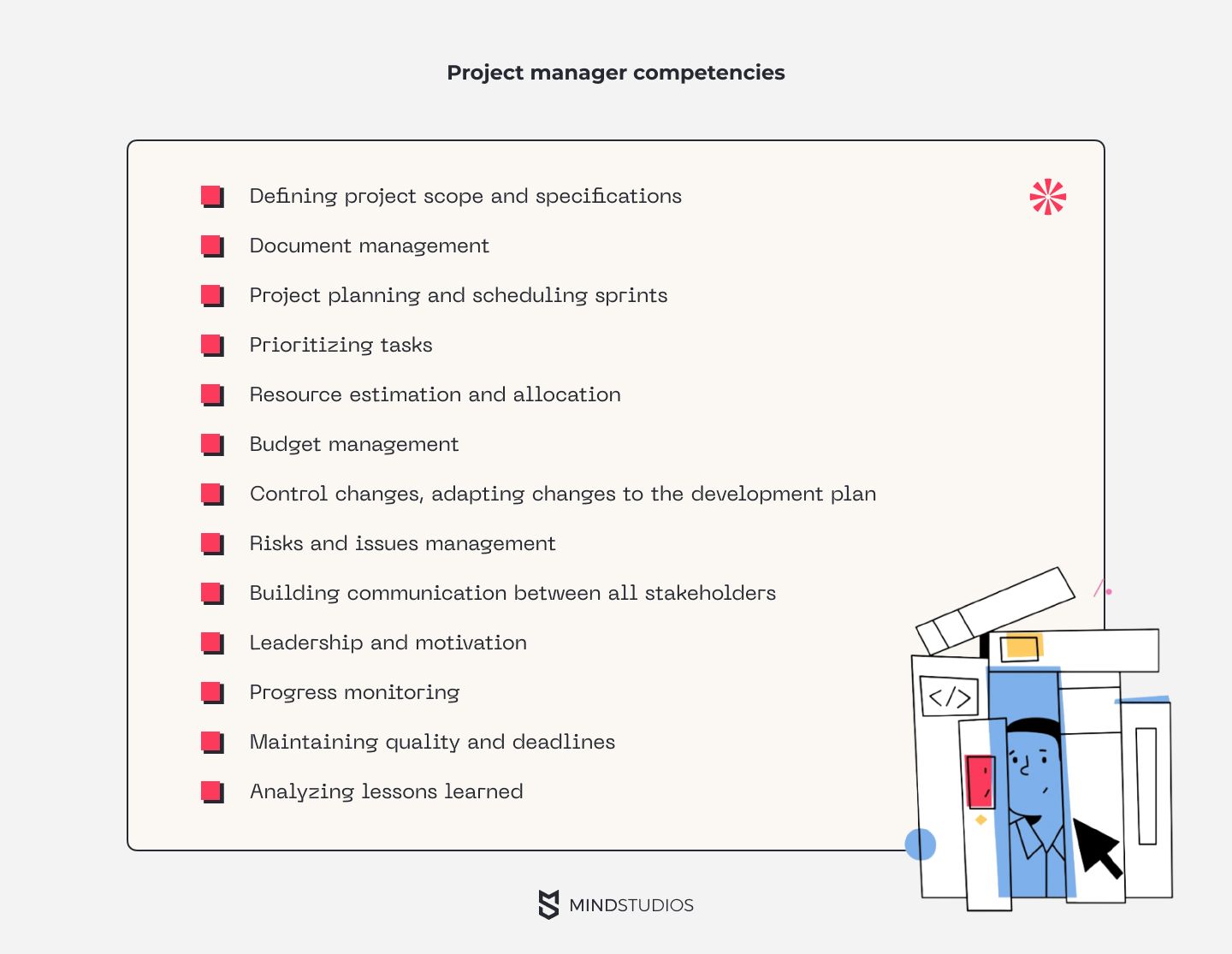
In short, your project manager needs to be a jack of all trades who oversees all app development stages. They should possess the following soft and hard skills:
- Leadership, communication, critical thinking, time management, teamwork, creativity, diplomacy
- Familiarity with different project management methodologies like Waterfall and Agile with the Scrum or Kanban frameworks
- Strong experience using project management tools like TeamGantt, Asana, and Confluence
A product manager identifies the viability of your app idea acquiring the data of competitiveness, specifics, and benefits of a new app that can be used to effectively develop it. A product manager is a strategist who:
- Analyzes the market; defines your app’s benefits, values, and core features; and examines your target users
- Identifies users’ vital problems and offers optimal solutions
- Compiles a business plan for app development
- Prioritizes worthwhile app features
- Extracts a unique value proposition and helps you form a powerful call to action
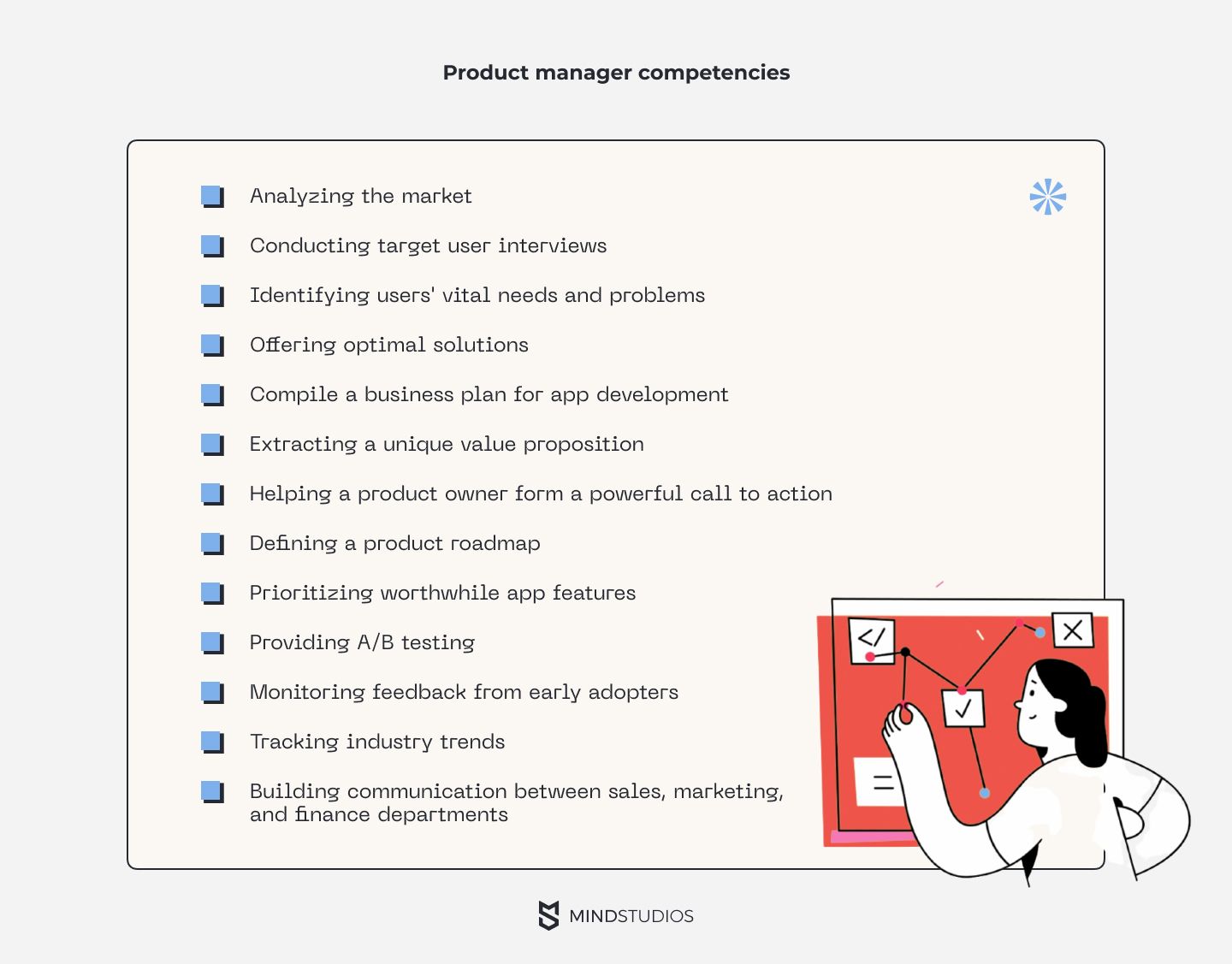
A product manager should have the same soft and hard skills as a project manager as well as strong experience using analytics tools like Firebase, Google Analytics, Mixpanel, and App Annie.
In some cases, the responsibilities of these two specialists are combined and performed by one person with the project manager title. However, if a project is complex and the scope is large, it’s efficient to divide the workload between a project manager and a product manager.
| Project manager | Product manager |
|---|---|
| Compiles project plan | Conducts product research |
| Defines project scope | Analyzes users’ needs |
| Provides cost/budget estimate | Compiles product roadmap |
| Sets deadlines | Defines features |
| Controls task completion | Tracks success metrics |
| Adopts changes and minimizes risks | Sets release requirements and app updates |
| Communicates progress to stakeholders | Communicates vision to stakeholders |
UI/UX designer
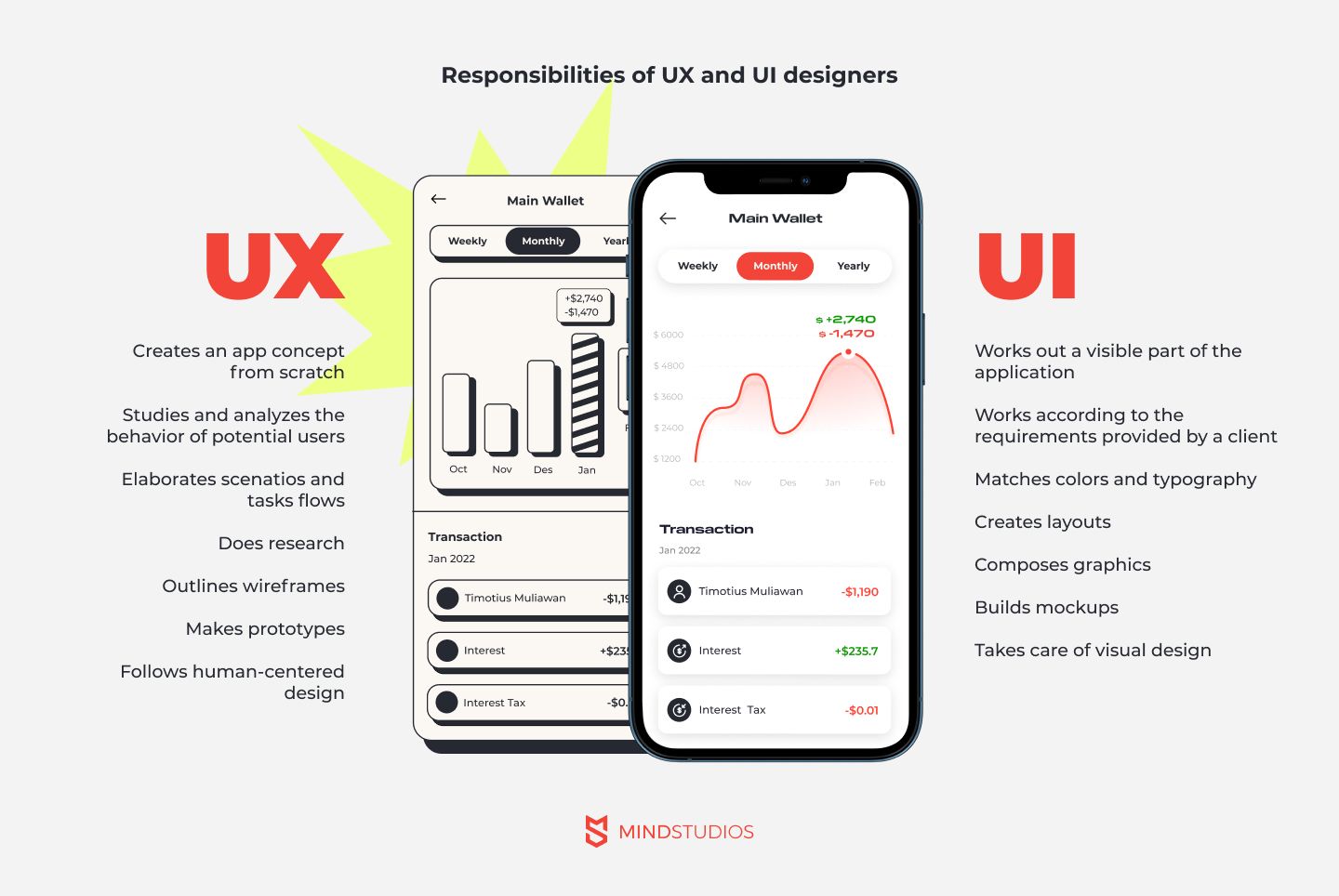
The main task of the UI/UX designer is to deliver a satisfying user experience by providing a concise, intuitive, interesting, and engaging app design.
It’s the responsibility of the UI/UX designer to:
- Create a user persona
- Think over the user flow and sketch app wireframes
- Create visual app prototypes
- Build intuitive app interface
- Make changes according to users’ feedback and testing data
Based on these responsibilities, you need to hire a UI/UX designer with the following skills:
- Expertise working with UI/UX design tools like Figma, InVision, and Sketch
- Up-to-date knowledge of UX research, wireframing, UI prototyping, and interaction design
- Some familiarity with coding to be on the same page with programmers
iOS and Android developers
The iOS and Android operating systems use different programming languages and have different requirements. That’s why you need a separate iOS app development team and Android development team for each platform. Whether you should build your app for one platform or both depends on your target audience and your budget.
In general, Android and iOS developers are responsible for the technical part of mobile app development:
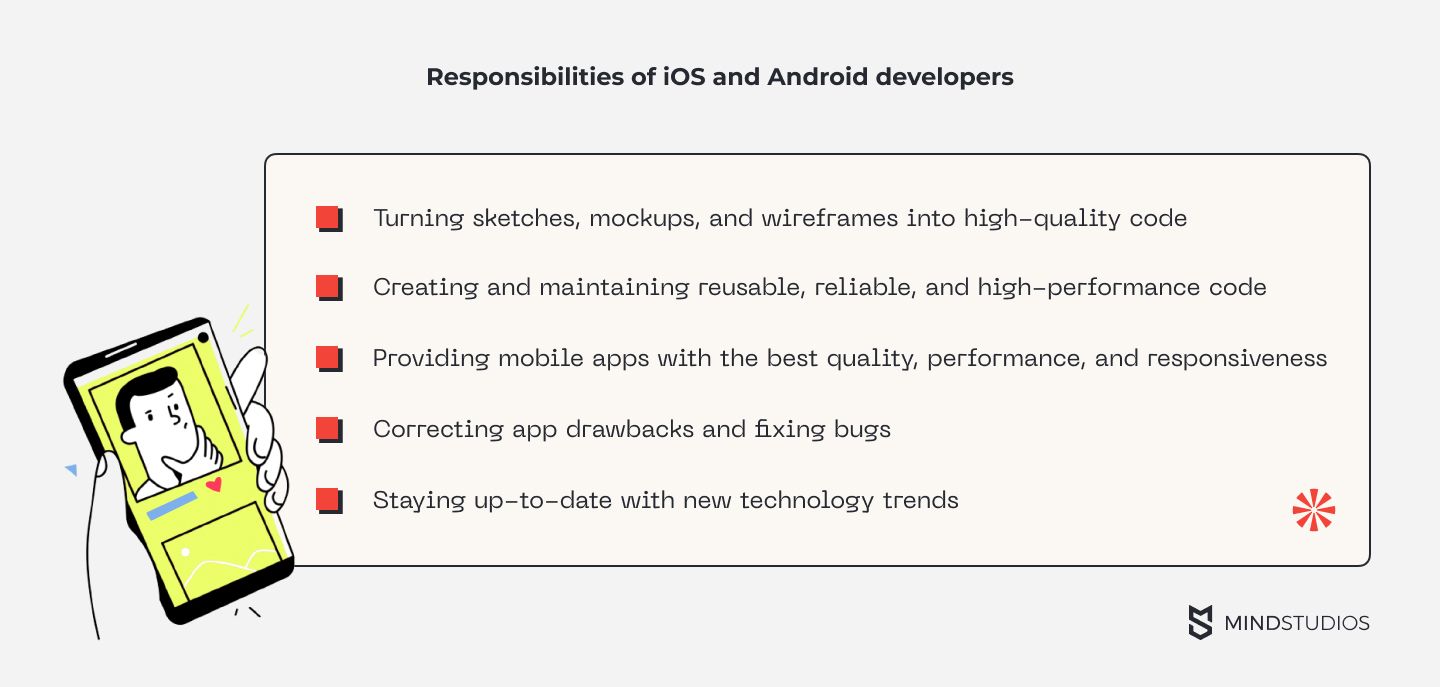
To make the hiring process less tedious, let’s dive deeper into skills that highly qualified iOS and Android developers should have.
Required skills for an iOS developer:
- Mastery of Objective-C and Swift to build native apps
- Knowledge of the Xcode IDE — the main development environment for macOS, iOS, and iPadOS apps
- A grasp of how to build apps for the last few generations of iOS and iPadOS
As for an Android developer, they must possess the following skills:
- In-depth knowledge of the Kotlin and Java programming languages
- Proven experience using Android Studio, the IDE for Android apps
- Ability to develop an app that supports different Android versions, devices, and screen sizes
There’s also an option to build a cross-platform mobile app with a write-once, run-anytime code recognizable across any platform. The cross-platform approach reduces development cost and speeds up the end app delivery but carries the app performance issues, a limited number of features, UX challenges, and more so.
When choosing cross-platform app development, you need to find a programmer with the following experience:
- Hands-on development experience with the React Native framework
- Cross-platform app development experience using the Xamarin, Flutter, or Ionic platforms
Backend developer
The backend developer manages a server working, cloud storage, and operational logic.
A backend developer is responsible for:
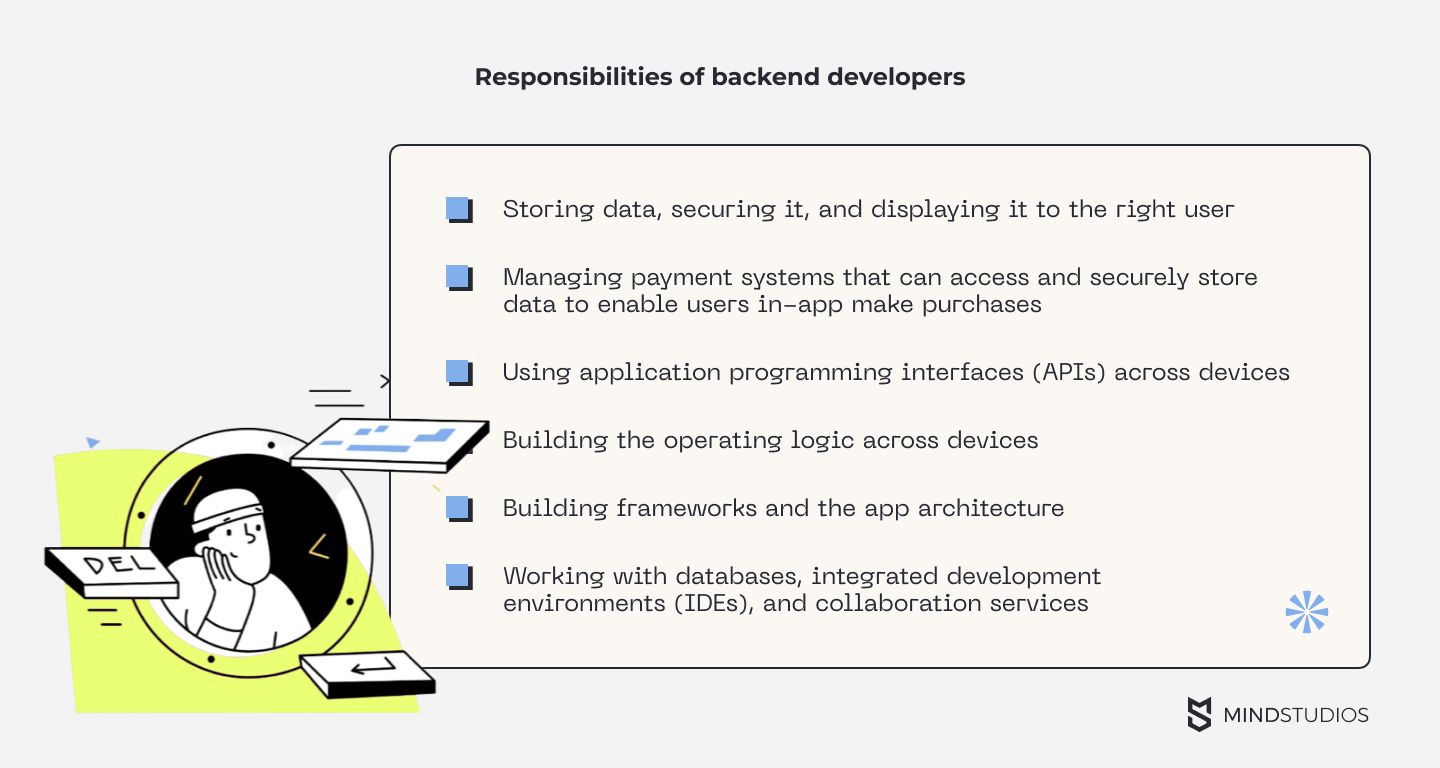
To manage all these tasks, a highly qualified backend developer should have:
- Hands-on experience with programming languages like Java, .Net, Python, PHP, or Ruby
- Experience with code versioning tools like Git
QA engineer
The main task of a quality assurance (QA) engineer is monitoring every stage of mobile app development to be sure the design and mobile software adhere to all requirements. The role of a savvy QA engineer in app development can’t be underestimated. Revealing app’s flaws and bugs on time helps you meet the project release deadlines and stick to the budget.
Let’s give a rundown of the QA engineer’s general duties:
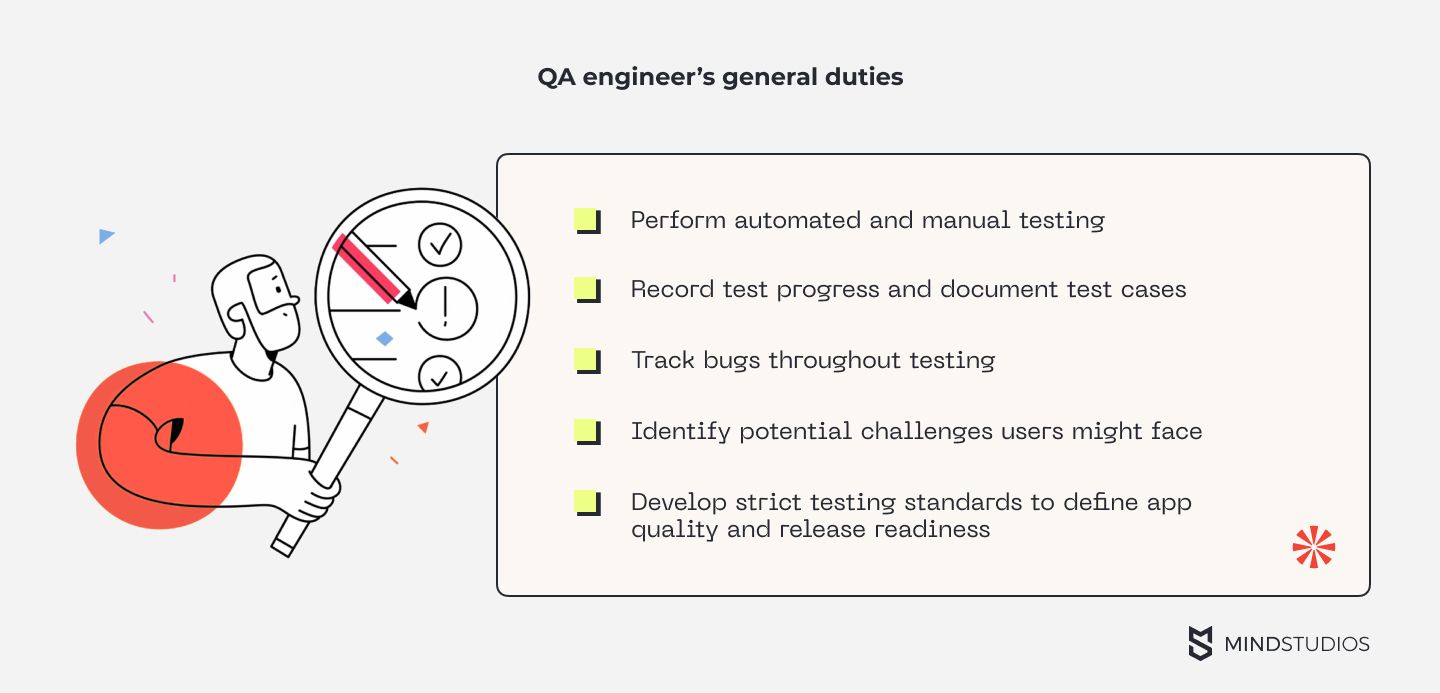
What skills except for teamwork should a highly qualified QA specialist possess?
- Strong experience using QA testing tools like TestComplete, Robotium, and Appium
- Knowledge of feature and bug tracking systems like Jira
Now let’s summarize what specialists come into play at each stage of app development.
App development stages and team roles
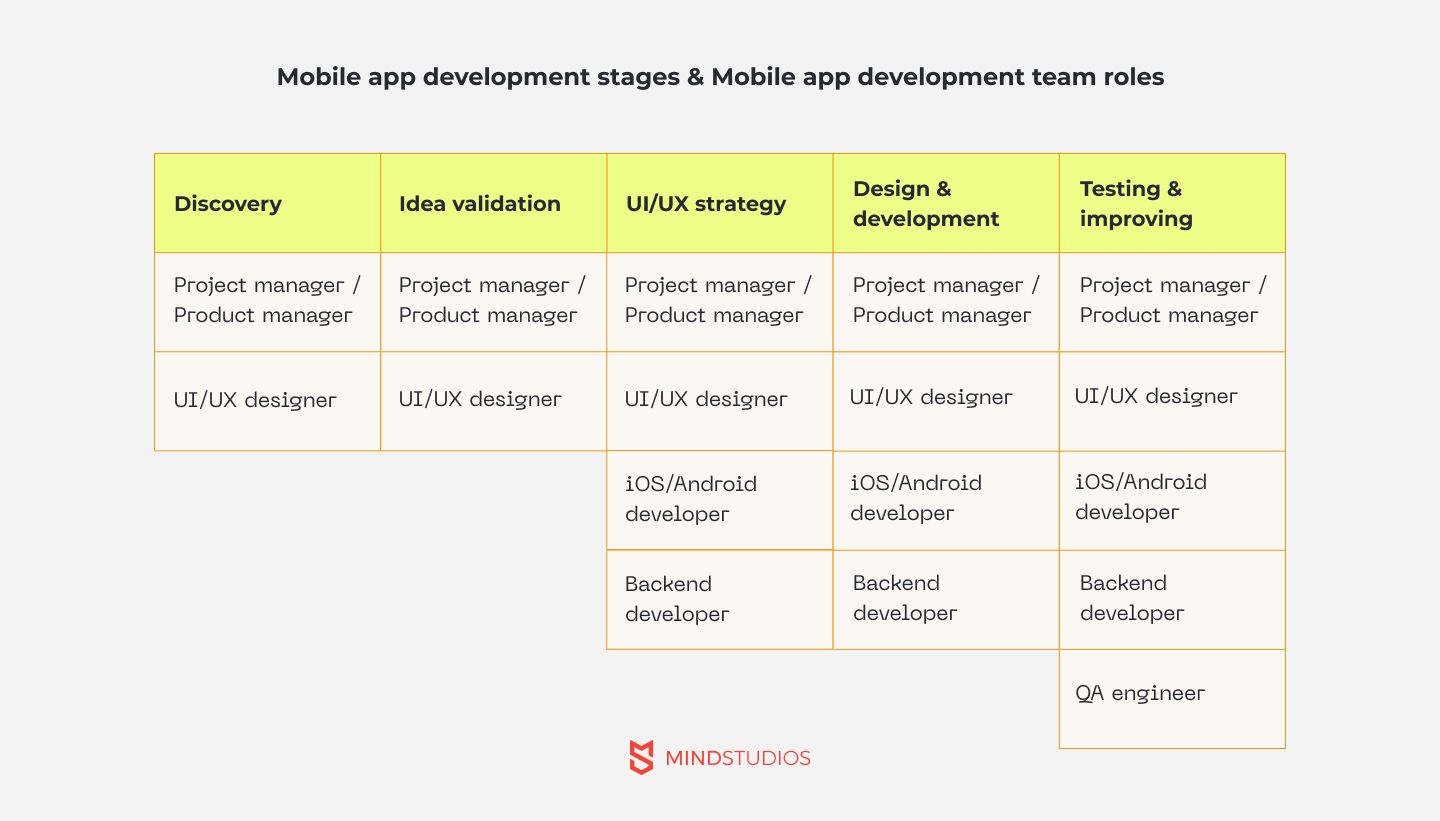
The app development process isn’t just about coding and design. Turning your app idea into an app requires a lot of skills, time, and money at the very beginning and tech support during the whole lifetime of the app.
We’ve divided the app development process into five main stages for simplicity to specify the software development team members who participate in each stage.
Stage 1 — Discovery. At this stage, you need to define app goals, values, and features, analyze competitors, identify the target audience, and visualize your app by sketching mockups. At the end of the discovery stage, you need to create a low-fidelity app prototype to be sure you and your development team are on the same page.
Stage 2 — Idea validation. At this stage, you should focus on determining your active and paying users and confirming your app’s relevance by analyzing initial users’ experiences using a concept validation prototype. Based on reactions from your audience, you can start to develop a medium-fidelity app prototype visualizing your app’s UX design and flow.
Stage 3 — UI/UX strategy. This is when you start to design a user interface in detail. You should create a high-fidelity app prototype, making it interactive so your testers can try the app’s navigation and give you feedback about the app’s convenience.
Stage 4 — Design and development. At this stage, your application development team starts coding and designing a minimum viable product (MVP) — a feature-oriented product with a precise design and convenient interface but still not a fully fledged mobile app.
Stage 5 — Testing and improving. This stage involves analyzing the user experience to fix all crashes and bugs and change everything required to make your app the best it can be. You can continuously add new app features and test whether they’re needed. Doing so will lead you to develop a fully functional and successful app.
Now let’s figure out the mobile app development roles according to the above-mentioned development stages.
At the discovery stage, you need to involve a project manager as the key figure in managing the whole app development process. You can also involve a product manager to dive deeper into your target users’ thoughts, needs, expectations, and motivations to use your app and make in-app purchases. Also, you need to add a UI/UX designer into the brainstorming process, compile a business concept, and transform the results of the discovery stage into visual mockups of the initial app prototype.
When you start to validate the app idea, you’ll require a project manager, a product manager, and a UI/UX designer. With the help of these specialists, you will be able to present an app idea to a development team and ensure all stakeholders have a common vision for your product.
To successfully complete the UI/UX strategy development stage, you need to use almost the entire development team: a project/product manager, UI/UX designer, iOS/Android developer, and backend developer.
At the design and development stage, the main load comes to the UI/UX designer, iOS and Android developers, and the backend mobile app developer. They report to the project manager and consult from time to time with the product manager.
Finally, when you move to the testing and improvement stage, the full app development team gets involved again.
Choosing the size of your app development team
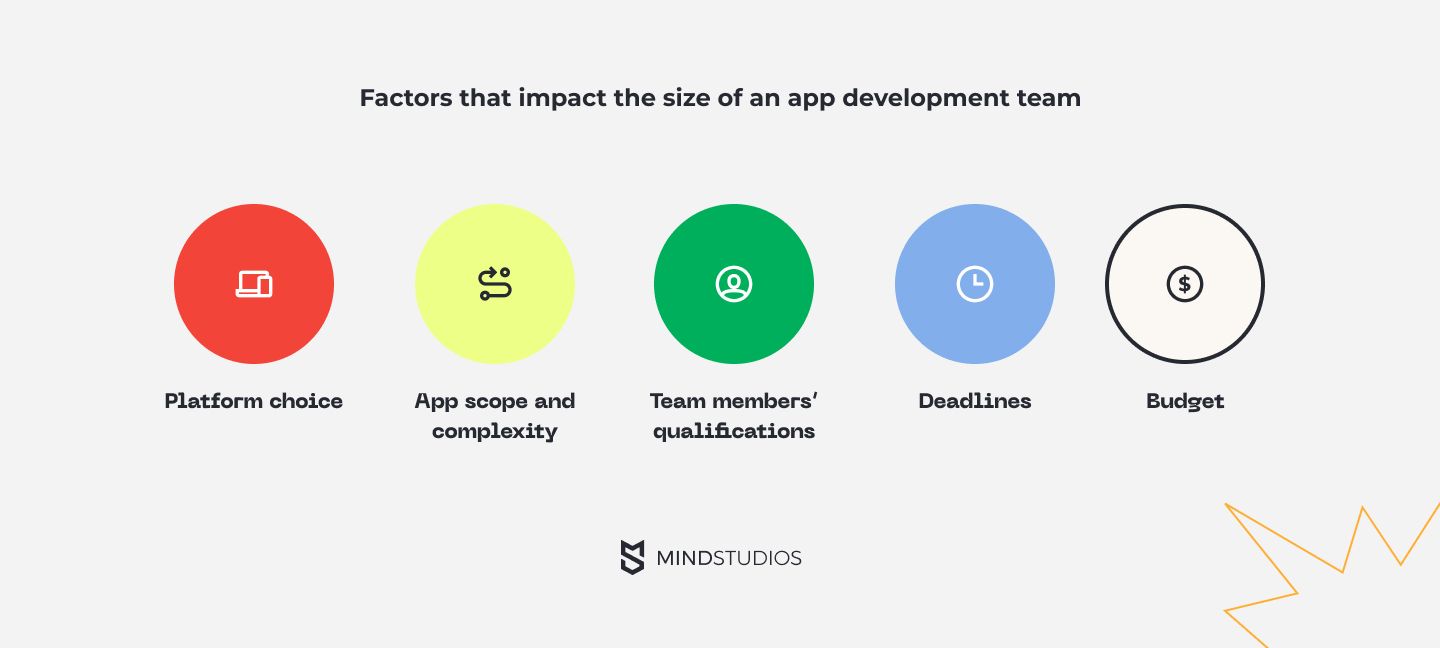
How many developers do you need to build an app? Assigning too few specialists in your app development process can prolong the development too much or result in poor development quality. In turn, bringing aboard too many specialists can boost your app development costs.
To choose the appropriate team size needed for your app startup, you should make an initial estimate of your project development scope. To do this, you need to consider the following factors:
- Number of platforms you’ve chosen to launch your app on
- Complexity of your app and the number of features you want to develop
- Expertise of your development team members
- Terms of app development
- Available funds
As for complexity, your app can fall into one of three categories:
- Simple apps have standard features, low-tech screens, ordinary buttons, and laconic designs.
- Medium apps offer more complex functionality along with more features, more screens, and more complex graphics.
- Complex apps need to provide high-tech app features, interactive graphic elements, chatbots, and payment services.
For example, if we’re talking about a full expert mobile application development team with a project manager, UI/UX designer, iOS or/and Android developer, backend developer, and QA engineer aboard, we can define the terms of completion for an app in each category as follows:
- Two to four months of work for developing a simple app
- Six to ten months to build an app with features of middling complexity
- Eight months or more for developing a complex app
If your goal is to bring your app to market quickly and your budget is ample, you can hire extra IT specialists and create your app faster. If you’re starting on a shoestring budget, you can simplify your app functionality, start implementing your app on one platform, or hire only a few specialists.
If you have difficulty estimating your app development costs and picking an optimal development team size, you can contact us for a free consultation.
Five models for hiring a staff needed to create an app
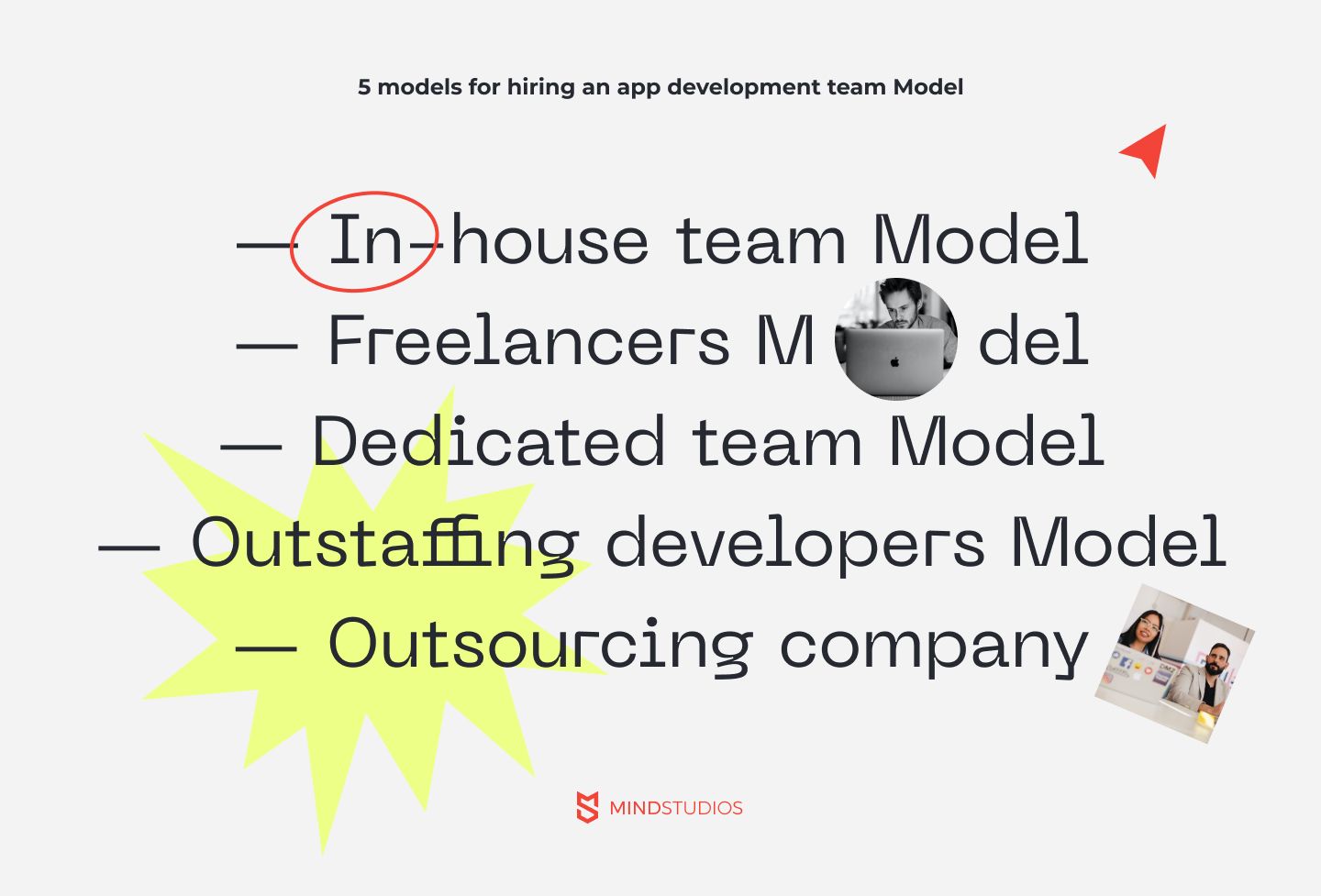
Now that you’re aware of the mobile app dev team structure, the distribution of roles in app development, and the team size that’s appropriate for your project, it’s time to figure out the best way of acquiring mobile app development experts for your project.
There’re five models for employing specialists to develop your app:
Model 1 — In-house developers. These are specialists sitting in your office and working full-time only on your project. Having an in-house development team enables you to control the app development process and recruit team members on your own.
Model 2 — Freelancers are useful when you need to hire individual specialists with a high level of expertise for solving one-time tasks. You can contact freelancers directly, and they’re likely to help you cut costs. You can choose freelancers by browsing their portfolios on freelance platforms.
Model 3 — A dedicated team is a group of remote IT specialists you can hire from a third-party service provider. This group will include designers, developers, and QA engineers who work under a project manager. They will work on your project and collaborate with your in-house developers while remaining employees of the third-party service provider.
Model 4 — Outstaffing means a third-party development company will provide you one or several specialists to complement your team needed to build an app and provide needed experience. Outstaffing specialists are employees of a third-party company but become part of your app design team and perform tasks you assign to them.
Model 5 — Outsourcing to a third-party company is optimal for delegating your entire project implementation from A to Z. Outsourcing means you completely entrust your app’s implementation to a third-party development company.
To help you make the right choice, we’ve highlighted the pros and cons of each model in the table below:
| Model | Pros | Cons |
|---|---|---|
In-house team |
|
|
Freelancers |
|
|
Dedicated team |
|
|
Outstaffing |
|
|
Outsourcing |
|
|
If you’re looking for more information, read the following articles:
- How to outsource mobile app development in 2023
- Dedicated team vs fixed price vs time and materials: what to choose for your project
How much does it cost to build an app development team?
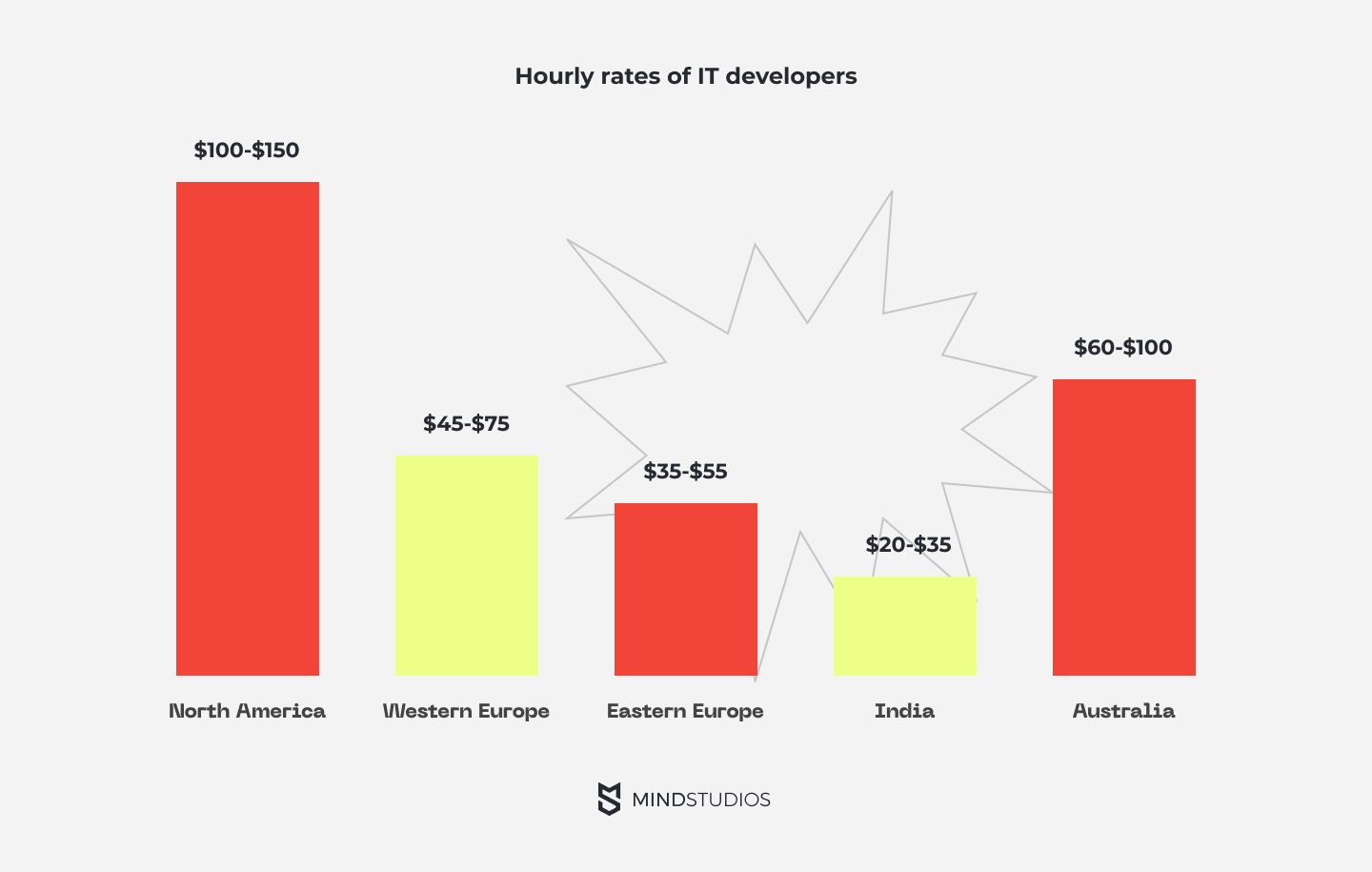
The following affect the cost of maintaining the team needed for an app startup:
- The region in which the team is located
- The cooperation model
- The type of employment (full-time, part-time, or hourly rate)
- Your project scope
Your goal is to develop your app at minimal cost but within the established deadlines and with high quality. To do this, for a start, let’s figure out the average annual salaries of full-time IT specialists in different locations based on Payscale salary reports:
| Team member | North America |
Western Europe |
Eastern Europe |
India | Australia |
|---|---|---|---|---|---|
Project manager |
$89,000 |
$57,000 |
$40,000 |
$20,000 |
$80,000 |
iOS developer |
$88,000 |
$48,000 |
$35,000 |
$16,000 |
$60,000 |
Android developer |
$88,000 |
$47,000 |
$31,000 |
$13,000 |
$63,000 |
Backend developer |
$76,000 |
$43,000 |
$30,000 |
$16,000 |
$57,000 |
UI/UX designer |
$74,000 |
$42,000 |
$32,000 |
$15,000 |
$55,000 |
QA engineer |
$70,000 |
$42,000 |
$23,000 |
$12,500 |
$57,000 |
If you decide to choose the in-house model for app development, keep in mind that an in-house team requires the biggest outlay because you need to pay salaries to your specialists as well as pay for:
- Work stations and office space
- Hardware and software
- Tools required for the development process
- Taxes, insurance, paid annual leave, retirement and savings contributions, benefits, and bonuses
According to the U.S. Small Business Administration, these extra expenses an employer needs to pay are typically 1.25 to 1.4 times the salaries. For European countries, the true cost of an employee can be 50% to 82% higher than the salaries. In Australia, the highest rate of employer payroll contributions is 47%; in India – 16,75%.
In our experience, to develop an on-demand grocery delivery app like Instacart, for instance, will take at least six months or 2,070 working hours of development that will be distributed across these stages of development:
| Development stage | Hours |
|---|---|
| Discovery | 80+ |
| Idea validation | 40+ |
| Visual prototyping | 60 |
| Design for Android & iOS platforms | 130–190 |
| iOS development | 600–800 |
| Android development | 500–800 |
| Backend development | 300+ |
| Admin panel development | 60 |
| Testing and improving | 300+ |
A project of this type will require the work of at least the following specialists:
- 1 project manager
- 1 iOS developer
- 1 Android developer
- 1 backend developer
- 1 UI/UX designer
- 2 QA engineers
The actual cost to develop an on-demand grocery delivery app with an in-house team will be as follows:
| In-house model | North America |
Western Europe |
Eastern Europe |
India | Australia |
|---|---|---|---|---|---|
Mobile app development cost |
$388,500 |
$240,750 |
$160,500 |
$61,294 |
$300,300 |
If you’ve decided to hire freelancers, you should know the average hourly rates of IT specialists in each region based on the Upwork data:
| Team member | North America |
Western Europe |
Eastern Europe |
India | Australia |
|---|---|---|---|---|---|
Project manager |
$60 |
$45 |
$35 |
$20 |
$52 |
iOS developer |
$62 |
$47 |
$35 |
$17 |
$45 |
Android developer |
$60 |
$45 |
$32 |
$15 |
$40 |
Backend developer |
$70 |
$45 |
$36 |
$17 |
$43 |
UI/UX designer |
$59 |
$38 |
$35 |
$16 |
$50 |
QA engineer |
$50 |
$32 |
$28 |
$15 |
$40 |
How much it will cost to develop a grocery delivery app if you hire freelancers?
| Freelancers | North America |
Western Europe |
Eastern Europe |
India | Australia |
|---|---|---|---|---|---|
Mobile app development cost |
$125,210 |
$89,120 |
$69,150 |
$33,940 |
$90,760 |
Now, let’s figure out how much it will cost to develop an Instacart-like mobile app with the help of a third-party outsourcing agency. Since an outsourcing company is a business that needs to make profit and also has expenses for office space, hardware and software, and so forth, their hourly rates are higher than freelancers’.
Let’s highlight the average hourly rates for outsourcing mobile app development companies in each region using the Clutch data:
| Outsourcing model | North America |
Western Europe |
Eastern Europe |
India | Australia |
|---|---|---|---|---|---|
The average hourly rates |
$150 |
$100 |
$50 |
$25 |
$120 |
Using these numbers, we can calculate the actual cost of the on-demand grocery delivery mobile app development run by an outsourcing company:
| Outsourcing model | North America |
Western Europe |
Eastern Europe |
India | Australia |
|---|---|---|---|---|---|
Mobile app development cost |
$310,500 |
$207,000 |
$103,500 |
$51,750 |
$248,400 |
If you refer to outstaffing firms to hire six specialists for your mobile application development team, they’ll charge a minimal fixed fee of 25% with the required specialists’ hourly wages. For example, if you and an outstaffing agency agree upon a UX/UI designer with an hourly rate of $35, you’ll need to pay them $43.75 per hour for the designer’s work.
In this case, the cost to develop a grocery delivery mobile app will approximately be:
| Outstaffing model | North America |
Western Europe |
Eastern Europe |
India | Australia |
|---|---|---|---|---|---|
Mobile app development cost |
$156,513 |
$111,400 |
$86,438 |
$42,425 |
$113,450 |
Dedicated team model implies monthly payments that depend on the number of team members including a contractor’s fee. In our estimate for the grocery delivery mobile app development, we included a fee of 10% but it can be lower or higher depending on your arrangements with a particular provider of a dedicated team.
| Dedicated team model | North America |
Western Europe |
Eastern Europe |
India | Australia |
|---|---|---|---|---|---|
Mobile app development cost |
$305,250 |
$176,550 |
$117,700 |
$57,750 |
$235,950 |
The chart below shows the cost of each cooperation model by region based on the scenarios described above:
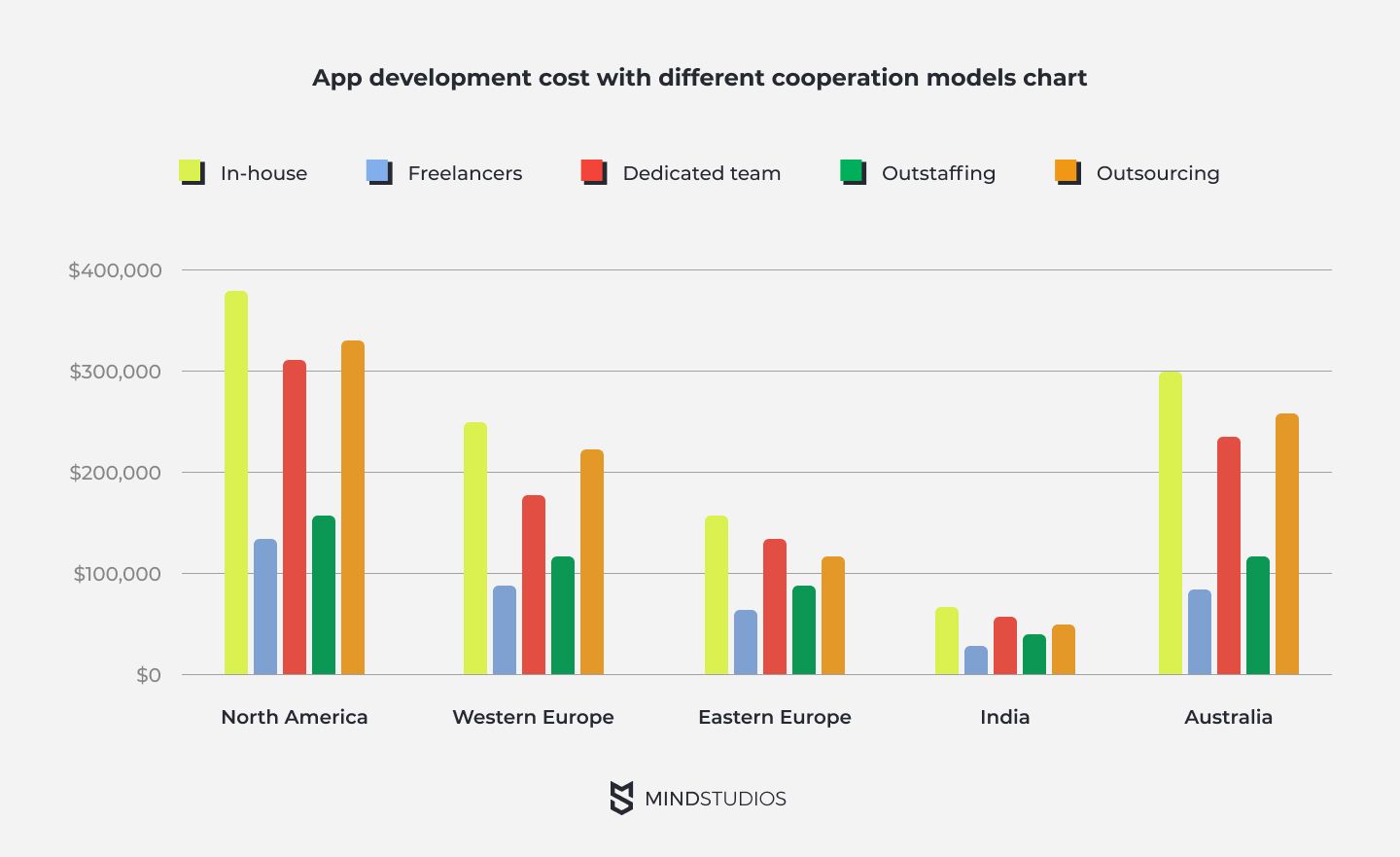
If you’re from a region with high hourly rates for IT specialists, the sensible answer for how to build potent app development teams is with an offshore outsourcing development company that has an existing team of savvy app developers.
If you want to learn how to cut app development costs, read these posts:
- App development cost breakdown: how much it costs to make an app
- How to reduce the cost of developing your app — best practices to follow
But what about the risk of running into unprofessional specialists? Doesn’t lower cost mean lower quality? The low hourly rates in Eastern Europe and Asia are not necessarily an indicator of a lack of expertise. The best evidence of an outsourcing development company’s competency is successfully implemented projects with high ratings in the app stores.
Where to find mobile application development experts
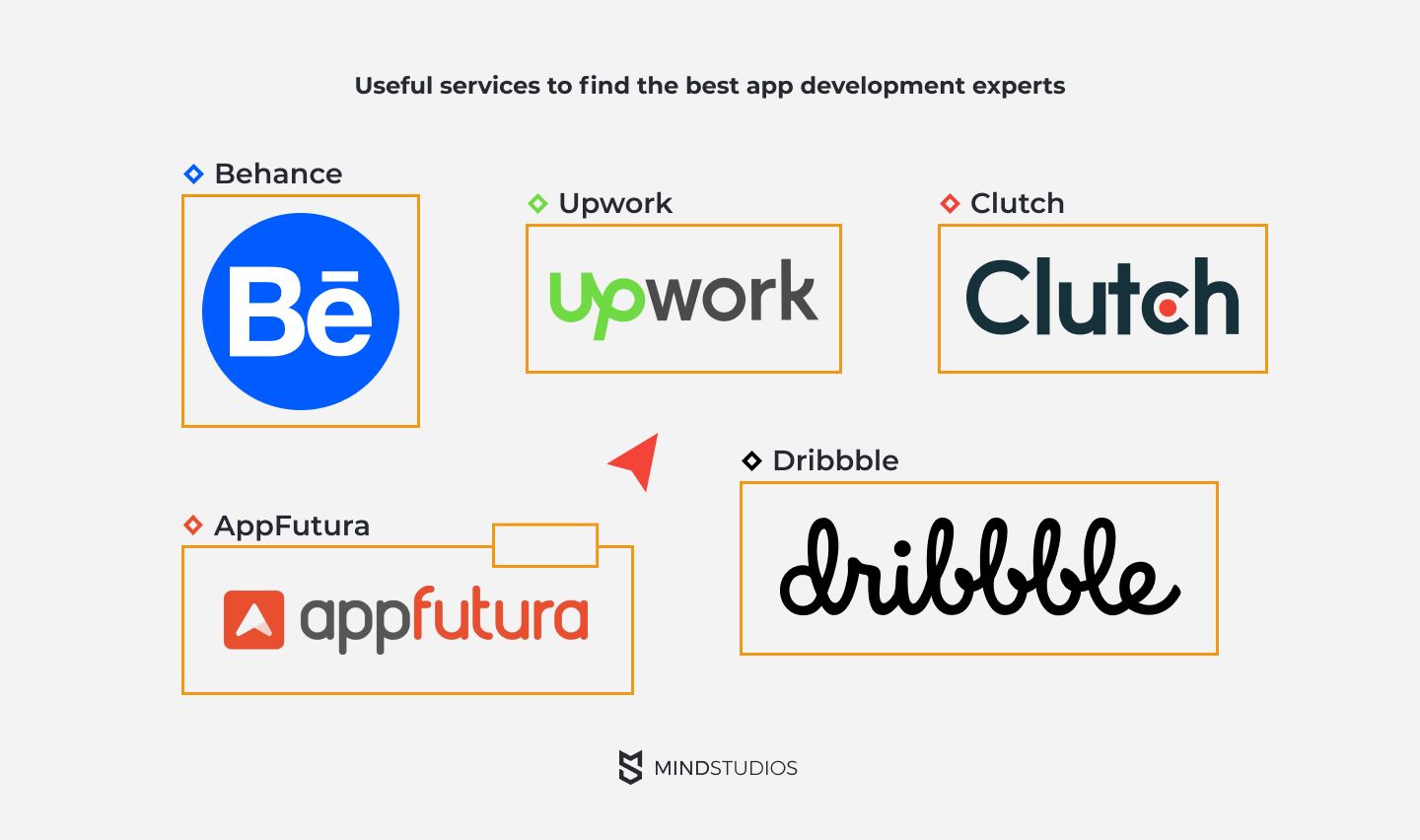
If you’re aiming to find an app development team in whom you can put your faith and trust, you should look at lists of the best app developers with ratings, reviews, examples of successfully implemented projects, and detailed information about their development approaches, expertise, and prices. You can find this information on sites like Clutch, AppFutura, Behance, Dribbble, and Upwork.
When looking through information on developers provided by these services, pay attention to the following criteria that your app developers must meet:
- Expertise. Look for high ratings for developed apps and positive reviews from previous clients.
- Development costs. Look for the ability to meet your financial capabilities along with the ability to maintain high product quality.
- Accessibility. Look for ease of communication, an absence of language barriers, and the ability to avoid time zone issues.
- Level of skills. Make sure a team’s capabilities correspond to your software engineering requirements and that the team applies top-notch technologies and effective development methodologies.
- Your personal preferences. See if you feel comfortable with the team while negotiating with them.
Difference between a mobile app and software development team structure
The organizational structure and size of your app development team can vary depending on the type and complexity of your project. For example, for building a mCommerce app where payments and profitability are the core, it may require involving a business analyst in the project.
A business analyst is responsible for compliance with business requirements, monitoring the efficiency of business processes, and how effectively a project carries out the stated business objectives.
Developing a website instead of a mobile app, you might also deal with different software development team structures. First of all, you’ll need to hire a front-end developer instead of an iOS/Android developer.
Front-end developers’ competencies are creating the design and structure of website pages, finding a balance between the aesthetics and functionality of the site.
To develop complex software like an electronic medical record system (EMR), you might require the help of a software architect and/or a DevOps engineer. They both are experts in software development and operations but have a core difference in their extended software development team roles and responsibilities.
A software architect is responsible for guiding the mobile or web app development team through the software development process by providing architectural blueprints, creating standards and procedures, identifying and resolving issues with design or coding. In turn, a DevOps engineer upholds collaboration between software developers and operation teams, evaluates the effectiveness of automated CI/CD (continuous integration/continuous delivery/continuous deployment) pipelines, and maintains the security controls to fasten a project release.
Like a living being, the composition of your development team will develop and expand while your project — a mobile app or other software — is evolving.
Consult with Mind Studios
In this article, we shared the most important tips on how to build a successful mobile development team.. Outsourcing to an app development company can be a reasonable decision because you get a tight-knit team of IT professionals who are ready to start immediately without spending time and money on tedious headhunting. If you need an app development team or an expert view on mobile app development, get in touch with us.

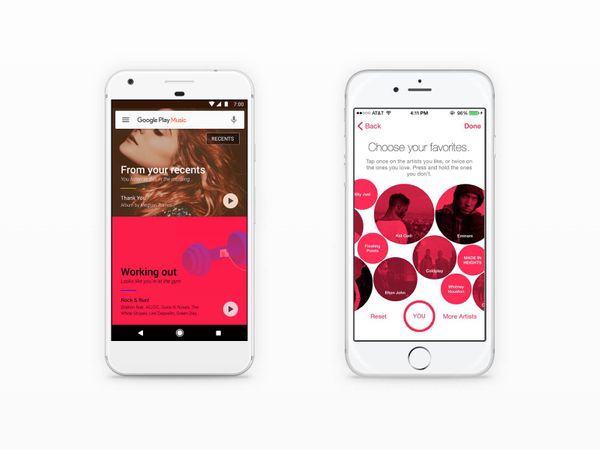
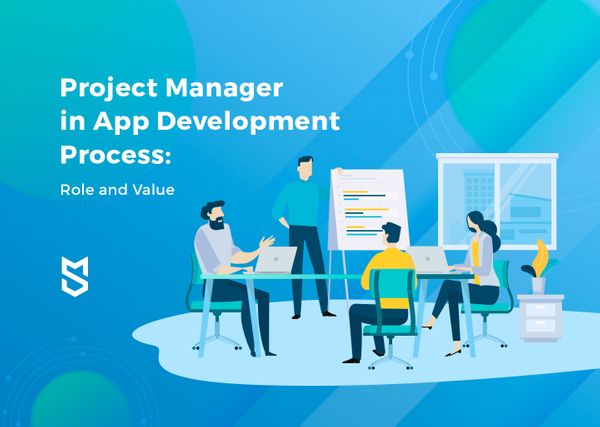

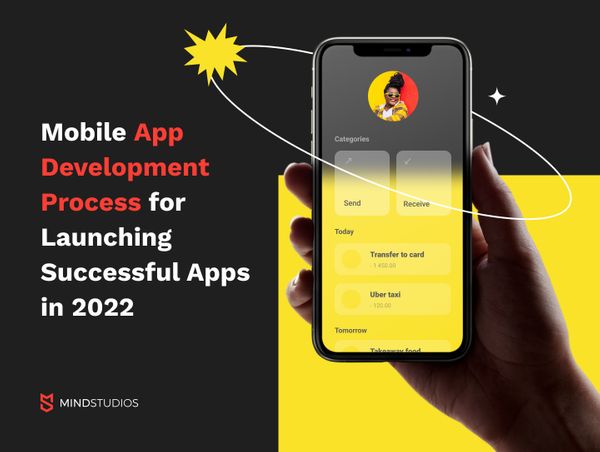
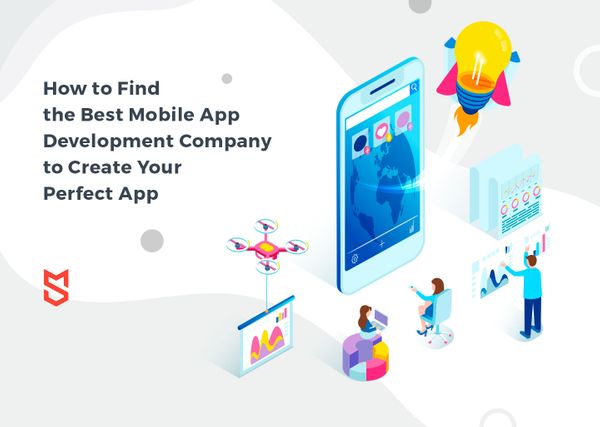
![How to Create an On-Demand Medicine Delivery App [Expert Guide]](https://themindstudios.com/blog/content/images/size/w600/2025/03/IMG-1-Cover-6.jpg)
